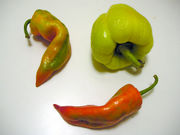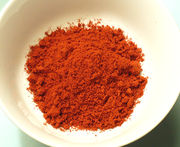Paprika

The various shapes and colors of the capsicum fruit used to prepare paprika.

A small bowl of Spanish pimentón

Packaged ground and whole dried paprika for sale at a Belgrade marketplace.
|
Paprika is a spice made from the grinding of dried fruits of Capsicum annuum (e.g., bell peppers or chili peppers). In many European languages, the word paprika refers to bell peppers themselves. The seasoning is used in many cuisines to add color and flavor to dishes. Paprika can range from mild to hot. Flavors also vary from country to country.
Contents |
Etymology
According to Hindu legend, paprika is said to have been named after a religious Indian figure named "Rysh Paprike".[1] In modern times, the word paprika is said to be derived from the Hungarian paprika, meaning pepper (Capsicum).[2] An alternative claim is that 'paprika' is derived from the Latin 'piper' (pepper) through Slavic diminutive forms ('pepperke', 'pipeka'), and came into currency in 1775.
Usage
Paprika is used as an ingredient in a broad variety of dishes throughout the world. Paprika is principally used to season and color rices, stews, and soups, such as goulash, and in the preparation of sausages as an ingredient that is mixed with meats and other spices.
Paprika was first produced in Spain, as that country was also responsible for the introduction of the bell pepper into Europe. In Spain, paprika is known as Pimentón, and is available in numerous varieties; pimentón ahumado, for example has a distinct smokey flavor and aroma, as it is dried by smoking, typically using oak wood. It is available in three versions, mild, moderately spicy and very spicy. Regular unsmoked paprika, known simply as Pimentón, is also available in the same varieties. Pimentón is a key ingredient in several Spanish sausage products, such as chorizo or sobrasada, as well as much Spanish cooking. Outside of Spain pimentón ahumado is often referred to as simply "smoked paprika" and can be found in varying intensities from sweet and mild (dulce), medium hot (agridulce), or very hot and spicy (picante).
Hungary is a major source of paprika and is thus more commonly used. It is available in grades ranging as follows: Special quality (Különleges) the mildest, very sweet with a deep bright red color. Delicate (Édes csemege) – color from light to dark red, a mild paprika with a rich flavor. Exquisite Delicate (Csemegepaprika) – similar to Delicate, but more pungent. Pungent Exquisite Delicate (Csípős Csemege, Pikáns) - an even more pungent version of Delicate. Rose (Rózsa) – pale red in color with strong aroma and mild pungency. Noble Sweet (Édesnemes) – the most commonly exported paprika; bright red and slightly pungent. Half-Sweet (Félédes) – A blend of mild and pungent paprikas; medium pungency. Strong (Erős) – light brown in color, the hottest paprika.
According to an old Hungarian saying, good paprika burns twice. Paprika contains strong spices, these may cause a burning sensation in the mucous membranes of the anus.[3]
Paprika can also be used with henna to bring a reddish tint to hair when coloring it. Paprika powder can be added to henna powder when prepared at home.
Nutrition
Capsicum peppers used for paprika are unusually rich in vitamin C, a fact discovered in 1932 by Hungary's 1937 Nobel prize-winner Albert Szent-Györgyi.[4] Much of the vitamin C content is retained in paprika, which contains more vitamin C than lemon juice by weight.[5]
Paprika is also high in other antioxidants,[6] containing about 10% of the level found in açaí berries. Prevalence of nutrients, however, must be balanced against quantities ingested, which are generally negligible for spices.
See also
- Capsicum
- Cayenne pepper
- Ajvar
References
- ↑ "Paprika is a Dried Fruit". The Theme Foundary. 20. http://demo.thethemefoundry.com/traction/2010/02/03/paprika-is-a-dried-fruit/. Retrieved 2010-08-15.
- ↑ Treasury decisions under customs and other laws, By United States. Dept. of the Treasury
- ↑ Lawless, Harry (1998, 1999). Sensory evaluation of food: principles and practices. Chapman & Hall. pp. 61. ISBN 0-8342-1752-X. http://books.google.com/books?id=BTR7VEJPDWAC&dq=Sensory+evaluation+of+food:+principles+and+practices.&printsec=frontcover&source=bl&ots=iVi-6d7iO4&sig=dCOq_gqxX-CPuZbVg_9ZA5YxQl4&hl=en&ei=LW0QS93nJs7GlAfrkp2xAg&sa=X&oi=book_result&ct=result&resnum=3&ved=0CBoQ6AEwAg#v=onepage&q=anus&f=false.
- ↑ ": Szeged, 1931-1947: Vitamin C, Muscles, and WWII:". The Albert Szent-Gyorgyi Papers. U.S. National Library of Medicine. http://profiles.nlm.nih.gov/WG/Views/Exhibit/narrative/szeged.html. Retrieved 2009-04-22.
- ↑ "Nutrition Facts Comparison Tool: Spices Paprika v. Lemon Juice Raw". Healthaliciousness. 2009. http://www.healthaliciousness.com/nutritionfacts/nutrition-comparison.php?o=2028&t=9152&h=102&s=100&e=100&r=. Retrieved 2009-07-27.
- ↑ "Oxygen Radical Absorbance Capacity (ORAC) of Selected Foods – 2007", United States Department of Agriculture, November 2007.
External links
|
|||||||||||||||||
|
||||||||||||||||||||||||||||||||||||||||||
